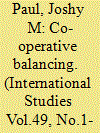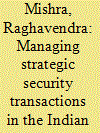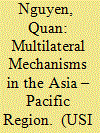| Srl | Item |
| 1 |
ID:
134107


|
|
|
|
|
| Publication |
2014.
|
| Summary/Abstract |
The Asia-Pacific region is facing the threat of a number of potential military conflicts. Unresolved security challenges include the Sino-Japanese and Sino-Indian territorial disputes. The current peace and stability in the region has been achieved through various multilateral mechanisms and constant US involvement in the regional affairs. However, the declining US presence in Asia, the ineffectiveness of different multilateral institutions to establish a security order in the region and China's possible emergence as a great power in Asia may lead to the end of the status quo. In this context, it is pertinent that Asia should be free from both hegemony and power rivalry, and for that, 'co-operative balancing' is the best possible mechanism to achieve a long-term peace and stability. Co-operative balancing is a combination of power balancing and a co-operative security framework. It promotes the independent position of individual countries and strengthens the multilateral mechanisms. This essay concludes that India and Japan can balance against China while bilateral engagement among the three countries tends to reduce their distrust vis-à-vis China.
|
|
|
|
|
|
|
|
|
|
|
|
|
|
|
|
| 2 |
ID:
133675


|
|
|
|
|
| Publication |
2014.
|
| Summary/Abstract |
The Indian Ocean Region (IOR) presents a unique tapestry of correspondences and divergences, positive and negatives, in an era of flux with world order, most likely, on the cusp of a systemic reordering. The geo-strategic salience of this region, as part of a larger global maritime continuum, has also increased. Strategic hedging behaviour by major stakeholders, resident and non-resident alike; besides securitisation of geo-political discourse that focuses on competitive aspects also present distinctive challenges for evolving a cooperative framework tailored to regional needs. The key issues examined for obtaining a pan-regional politico-strategic rapprochement are the tenets of critical geopolitics, game theory, geography, context and the efficacy of existing multilateral mechanisms, especially Indian Ocean Rim Association (IORA). The overall aim is to examine the various intertwined threads for formulating an inclusive and multi-sectoral maritime security framework with an IOR contextualisation.
|
|
|
|
|
|
|
|
|
|
|
|
|
|
|
|
| 3 |
ID:
168107


|
|
|
|
|
| Summary/Abstract |
In the 21st Century, the Asia-Pacific has gained geo-strategic prominence because of its importance for both, regional and global security. Regional multilateral mechanisms have grown after the end of the Cold War. The growth has not only been in numbers, but also in terms of participants, cooperation agenda and programmes. This may either contribute towards strengthening centrality of Association of South East Asian Nations (ASEAN), or cause obstacles in its functioning. The influence of ASEAN has decreased in recent years. So far, ASEAN has been considered strategic fulcrum for Vietnam’s foreign policy. Together with other ASEAN members and its partners, Vietnam should make efforts to support, maintain and promote ASEAN’s centrality in regional multilateral security architecture for peace, security and stability.
|
|
|
|
|
|
|
|
|
|
|
|
|
|
|
|